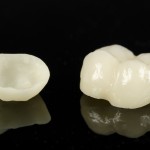
The aim of this study was to evaluate the clinical outcome of shrinkage-free ZrSiO4-ceramic full- coverage crowns on premolars and molars in comparison with conventional gold crowns over a 5-year period.
Invited patents who required posterior crowns were randomised to receive either a shrinkage-free ZrSiO4-ceramic crown (test group) or a gold crown (control group). The prospective abutment teeth received appropriate treatment (core build-up, root canal treatment or post and core placement) before preparation fro crown preparation. Before cementation, a radiograph of the abutment teeth and crowns was taken to evaluate the marginal fit and the periapical region. All crowns were cemented with a glass–ionomer cement. All treatments were carried out in the University Dental Hospital Freiburg. The parameters’ surface roughness, fracture, marginal integrity, secondary caries at the crown margin, margin discoloration, marginal gap and crown loss were evaluated 6, 12, 24, 36, 48 and 60 months after insertion
- 123 shrinkage-free ZrSiO4-ceramic crowns were placed in 123 patients, and 100 patients received 100 gold crowns. Mandibular first permanent molars were the most commonly treated tooth.
- At 5 years there were 46 patients lost to follow-up in the ZrSiO4 group (37%) and 19 in the control group (19%).
- At 5 years the Kaplan-Meier survival probability was 73.2% for ZrSiO4-ceramic crowns and 92.3% for gold crowns.
- The ceramic crown group had a 3.13-fold higher probability of failure than the gold crown group.
- Gold crowns showed a better marginal integrity with less marginal discoloration than the ceramic crowns.
- The most common failure in the ceramic crown group was fracture of the crown
The authors concluded
The 60-month results of this prospective randomised controlled clinical trial suggest that the use of these shrinkage-free ZrSiO4-ceramic crowns in posterior tooth restorations cannot be recommended.
Comment
The authors note that the ZrSiO4-ceramic is no longer distributed by the company KaVo Dental GmbH (Biberach/Riss, Germany), who supported this study financially. This highlights one of the challenges associated with restorative studies. Material science is constantly evolving with new generation of materials becoming available before medium to long term clinical data is available for clinicians to make their treatment decisions on.
Links
Passia N, Stampf S, Strub JR. Five-year results of a prospective randomised controlled clinical trial of posterior computer-aided design-computer-aided manufacturing ZrSiO(4) -ceramic crowns. J Oral Rehabil. 2013 Jun 8. doi: 10.1111/joor.12075. [Epub ahead of print] PubMed PMID: 23745725.
